The Passage to India
The British dominions in India took shape gradually. In the very early years of the 17th century British merchants of the East India Company set out to trade with the fabulous Mughal empire. As that empire declined, the British took political and military control of Indian territory, defeating the French and various Indian rulers to become the dominant power. Britain ruled India through the East India Company until after the terrible rebellion of 1857-58, when India came to be ruled directly by the British crown.As the British presence in India grew, Britons increasingly went to India to run businesses and as administrators, soldiers, and missionaries. By the 19th century and into the 20th a life in India became a regular existence for many English men and women. Their personal motives were various: to make money, to find excitement, to improve their status, to maintain family tradition, and -- as a grand ideal of imperial service formed in Victorian times -- to serve their own nation and India itself. In many ways their personal motives are a microcosm of the reasons European nations and their societies sought imperial expansion.
Sometimes generations of the same family went to India. Some were born there, others recruited out of university or public school to join the police or the civil or the education or forest service. Whatever their backgrounds, those who went found themselves on a journey to a world very different from what they knew in the British Isles. Their literal passage on a steamship -- from cool England, through Gibraltar and across the increasingly foreign Mediterranean, through the Suez Canal (symbolic divider of West from East), into the sun-scorched Red Sea and steamy Indian Ocean to a land full of new sounds, sights, and smells -- was more than a mere trip but a rite of transition which often made a powerful impression.
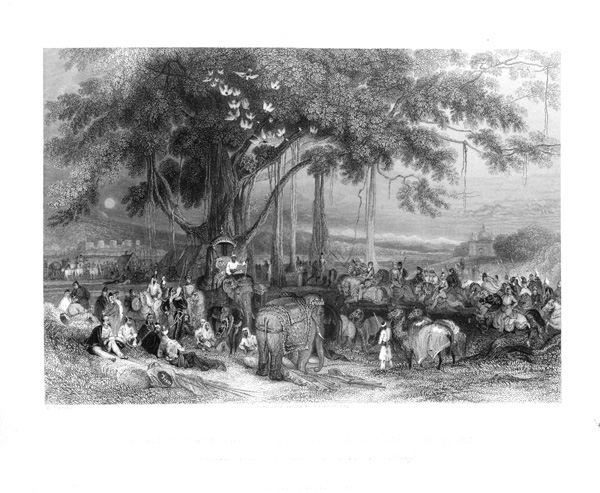
 "Runjeet Singh and His Suwarree, or Cavalcade of Seiks"; steel
engraving after a drawing by G.F. White; 1837.
"Runjeet Singh and His Suwarree, or Cavalcade of Seiks"; steel
engraving after a drawing by G.F. White; 1837.
Maharaja Ranjit Singh, who ruled his co-religionist Sikhs in a kingdom that centered on the Punjab, was the last powerful independent ruler on the Indian subcontinent, others having been defeated, their lands annexed by the expanding British dominion. After his death in 1839, the Sikh kingdom also crumbled to British power.
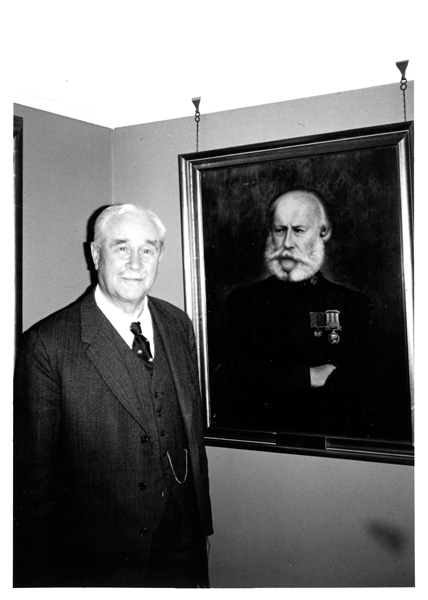 Family tradition: Colonel W.A. Salmon,
who served in India in the 1930s with the Highland Light Infantry
and as aide to the Governor of Sind, poses with a portrait of an ancestor
who was in East India Company Service; photograph by
Rosan Augusta Jordan; 1979.
Family tradition: Colonel W.A. Salmon,
who served in India in the 1930s with the Highland Light Infantry
and as aide to the Governor of Sind, poses with a portrait of an ancestor
who was in East India Company Service; photograph by
Rosan Augusta Jordan; 1979.
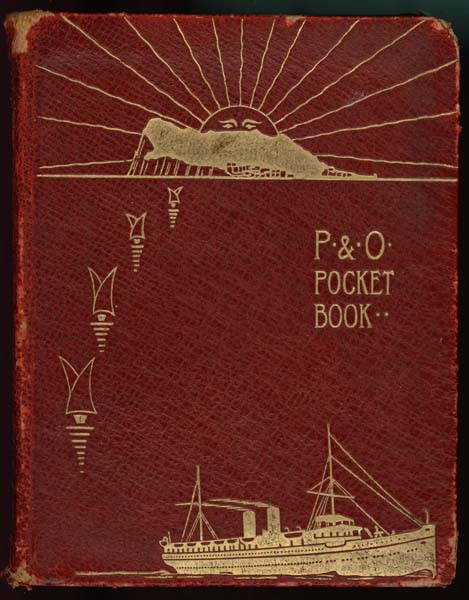 The P. and O. Pocket Book, 2nd edition (London: Peninsular and
Oriental Steam Navigation Co., 1899).
The P. and O. was widely considered the premier shipping line for
transportation to India ("a junior branch of the Royal Navy,"
according to some). The little guidebook provided for passengers
(first published in 1888) included information on ports of call,
essays on countries served, advice for travellers, maps, and
meteorological tables.
The P. and O. Pocket Book, 2nd edition (London: Peninsular and
Oriental Steam Navigation Co., 1899).
The P. and O. was widely considered the premier shipping line for
transportation to India ("a junior branch of the Royal Navy,"
according to some). The little guidebook provided for passengers
(first published in 1888) included information on ports of call,
essays on countries served, advice for travellers, maps, and
meteorological tables.
 Souvenir spoon from the P. and O. liner "Himalaya"; 1950s.
Souvenir spoon from the P. and O. liner "Himalaya"; 1950s.
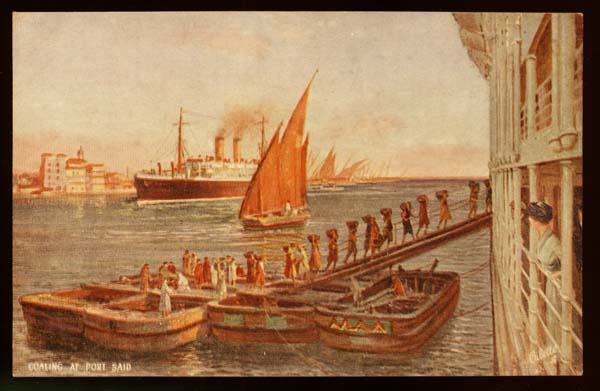
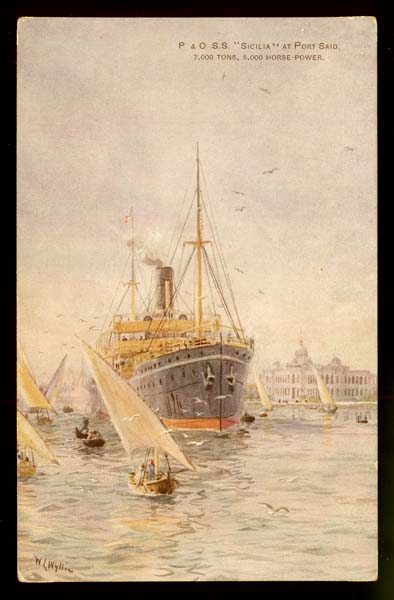


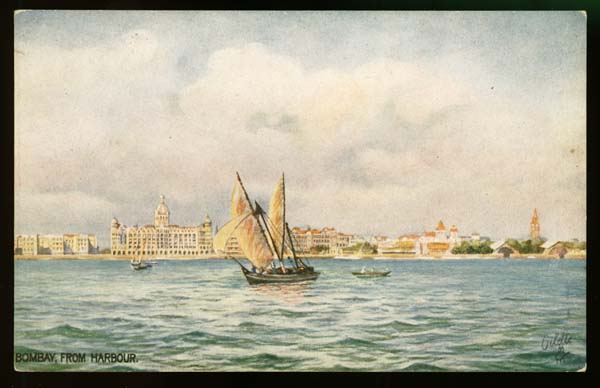
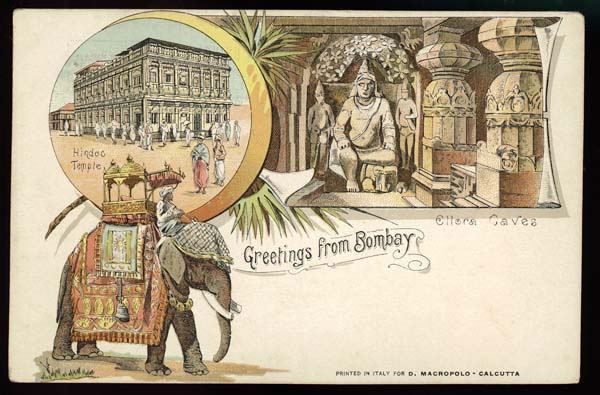


 Postcards (late 19th century-1920s) trace the voyage through
Suez to Indian destinations. Cards depicting vessels were produced
by Raphael Tuck and Sons and provided to travelers by steamship
companies, in this case the P. and O. and the Orient Lines.
"Bombay, from Harbour" is from a Tuck "Bombay" series.
Postcards (late 19th century-1920s) trace the voyage through
Suez to Indian destinations. Cards depicting vessels were produced
by Raphael Tuck and Sons and provided to travelers by steamship
companies, in this case the P. and O. and the Orient Lines.
"Bombay, from Harbour" is from a Tuck "Bombay" series.


Finally, "I land in India," in Raven-Hill's Indian Sketch Book by L. Raven-Hill (London: "Punch" Office, 1903). Englishmen arriving in India were a popular subject for illustrations, often humorous ones. Such illustrations commonly depict his confusion or discomfort upon first encountering the "natives" and are indicative of the feeling of entering a very different world that many British encountered upon going to India.

An Introduction:-
1. The Passage to India
2. Running Your Empire
3. Life in the Bungalows
4. Imperial Diversions
5. Never the Twain?
6. No more India to go to
Chapter 2 interviews
Chapter 3 interviews
Chapter 4 interviews
Chapter 5 interviews
Chapter 6 interviews